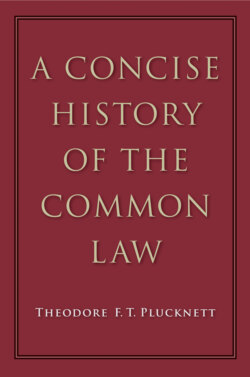Читать книгу A Concise History of the Common Law - Theodore F. T. Plucknett - Страница 39
На сайте Литреса книга снята с продажи.
EDWARD I AND FEUDALISM
ОглавлениеThere is one general aspect of Edward I’s legislation which has especial interest. This is the belief of many historians, expressed in several different forms, that there was something anti-feudal in his policies.2 We have already mentioned the fact that the Statute of Marlborough was passed under his influence and is historically part of the great mass of legislation passed in Edward I’s reign, and so we shall consider it together with the statutes of Westminster the first and second, and especially the statute of Quia Emptores. Of the Statute of Marlborough Maitland wrote that “in many respects it marks the end of feudalism”,3 and of Edward’s legislation as a whole Stubbs wrote that it endeavoured to eliminate the doctrine of tenure from political life.4 These two statements, sometimes repeated in less guarded language by other historians, deserve more minute examination than can be accorded them at the present moment, but a few general observations can be made.
It would indeed be a remarkable tribute to the intellectual powers of Edward I if it could be shown that he set his face against the whole pattern of contemporary society as it existed throughout civilised Europe. The demand for a new social structure is common enough in our own day because we have numerous examples, both contemporary and in the history of the last two generations, of revolutionary attempts to remodel society on the lines of military and economic dictatorships, communes, soviets and the like. But it is hard to imagine a statesman of the year 1300 suggesting an alternative to the social structures over which three such legal-minded monarchs as Edward I, Philip the Fair and Boniface VIII presided.
If Edward’s legislation is examined, it will be seen that its general tendency is not to weaken, but to strengthen, the position of feudal lords. Lords must have been grateful for two statutes which gave them immense power over their bailiffs;1 the feudal rights of wardship and marriage were protected by new civil and criminal procedures;2 the default of tenants in paying services (which at this moment left the lord in a very weak position) was for the future visited with the forfeiture of the tenement;3 and lords were also given extended powers of appropriating commons.4 Most striking of all, Edward I risked a bitter quarrel with the Church over mortmain in order to prevent lords losing their feudal incidents when land passed to ecclesiastical bodies,5 and Quia Emptores itself was designed in order to preserve those same rights of wardship, marriage, relief and escheat.6 Continued sub-infeudation would probably have introduced such chaos into the system of tenures that these incidents would have eventually been evaded almost universally, but Quia Emptores perpetuated them. Edward I certainly did a great deal for the feudal lord. But he was not prepared to tolerate abuses, and he was equally active in assuring to tenants their rights. Many great statutes defined the law of distress and replevin,7 and the action of mesne (which protected a sub-tenant when his lord defaulted in services to the lord above) was made more practicable.8 There seems no escape from the conclusion that this legislation assumed the reasonableness and desirability of the feudal structure, and deliberately strengthened it. The fact that all the incidents of military tenure survived until the sixteenth century, and that the persons interested in them were to enjoy them for an additional century (thanks to the statute of uses), is all testimony to the soundness of the legal structure of feudalism as Edward I left it. His policy in fact was based on that simple and straightforward idea of “justice” which was taken as an axiom in the middle ages—the rendering to every man his own. Edward assured to the tenant the peaceful enjoyment of his lands with the same impartial justice as he confirmed to the lord the fruits of his seignory.
